Serena Lu is a big name in the world of rhythmic gymnastics. She was a USA national team gymnast for seven years, rhythmic Sportsperson of the Year in 2016 and 2017, and competed at the 2014 and 2015 World Championships and the 2017 University Games. In 2016, Serena began her first year at Princeton University. Unlike most rhythmic gymnasts, who retire from the sport once they begin college, Serena made the ambitious decision to continue her gymnastics career alongside being a full-time university student. After a grueling freshman year of attempting the near impossible task of juggling an Ivy League course load with competitive gymnastics, Serena decided to retire from the sport at the age of 20. She recently completed her third year at Princeton University, pursuing a degree in psychology whilst on the pre-law track. Her story is one of success, determination, heartbreak, and tumult.
Growing Up
Serena began rhythmic gymnastics at the age of 5. Her older sister, Cindy, also did rhythmic gymnastics and was on the national team as well. The Lu sisters’ mother was exposed to rhythmic gymnastics briefly in China. One day, she saw an advertisement for rhythmic and thought it would interesting to put her girls in the sport. Both Cindy and Serena fell in the love with rhythmic gymnastics from the very beginning, and never looked back since.
Serena first trained in Minnesota at Twin Cities Rhythmic. In 7th grade, she and her family moved to New York, where she trained for the rest of her career at the prestigious Isadora Rhythmics, home to many current and former national team members.
Growing up, Serena was involved in many activities alongside gymnastics. “When I started rhythmic, I was also doing a lot of other things at the same time. I had been very involved in acting and drama. That was one of my first passions that I vividly recall. But due to time I had to limit the things I was doing. Eventually, it ended up being rhythmic, piano, and ballet. I was very active in piano. At one point I was thinking about going to a conservatory and becoming a professional pianist. With the move to NY, I started focusing on rhythmic more, because it came at a time in my career that things got more serious. Training got longer and more frequent. Because I had all these passions when I was younger, it helped with my gymnastics. The acting gave me a strong sense of artistry and emotion, and the music part helped as well. I’m still very passionate about music and try to play piano as much as I can in college.”
Serena attended public school her entire life. From a young age, she was forced to learn the art of time management, as she attended a very competitive, specialized high school with a rigorous curriculum. When asked how she managed, Serena says, “I had training 6 days a week. I had only one free day in the week, so I told myself that I would do as much as I could in my free time. At one point, I was on the debate team and wrote for the school newspaper. I helped my best friend start a baking club in high school! My sister and I would practice piano in the evenings. For the other 6 days, I had training on average for 5 hours a day, sometimes longer on the weekend. It sometimes took up to 1.5 hours travelling to the gym due to traffic. After training, I would go home and do school work. I’d try to do everything in the car and after school. On a typical day, I would be up until 1am or 2am. Anytime I was free, I would be doing schoolwork or studying for standardized tests and applying for colleges.”
Serena cites her sister, Cindy, as one of her greatest role models and inspirations, without whom she wouldn’t have been able to manage all of her commitments. “My sister is definitely more responsible than I am. Without her I wouldn’t have been able to do everything myself. Once she graduated high school, I had to maintain the responsibility and discipline and balance everything. I am beyond lucky to have her as a role model. We did everything together.”
In 2009, Serena competed at her first international competition for the US. She was officially on the USA National Team between the years 2011 and 2018.
Accomplishments in Gymnastics
When asked what her greatest achievement in the sport was, Serena replied, “For me this is a question that I kind of interpret differently from other people. To me it isn’t about the competitions I went to, or some of the highest scores I’ve gotten, but about two instances where I feel like I reached my maximum potential.”
The first of these instances was the 2015 World Championships, which also was the qualifications for the 2016 Rio Olympics. “Being on the World Championship team was already a great achievement. But getting to support my teammates in the finals and seeing Laura [Zeng] qualify for the Olympics was the greatest achievement. I had known her since I was 8 or 9 years old, and we had grown up together in the sport and had been roommates for ages. She’s my best friend. I started crying when she qualified [for the Olympics]. The World Championships was one of my greatest achievements for myself as well, because [2015] was a really hard year for me, and being able to compete at Worlds and do the best I could have possibly done for myself and for the US was an amazing accomplishment.”
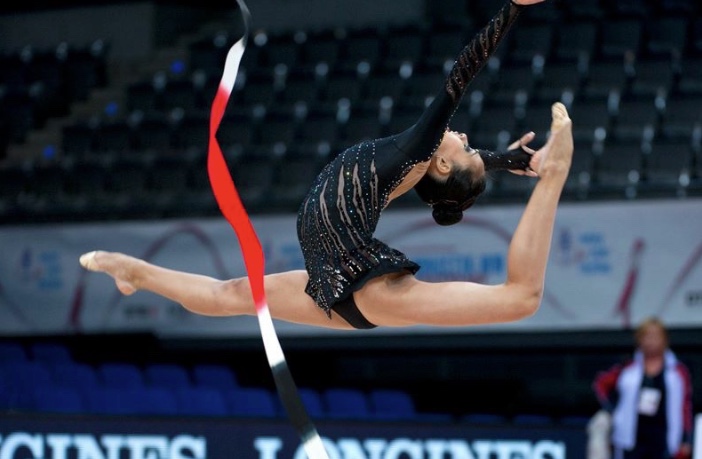
2015 World Championships

2017 University Games (Taipei, Taiwan)
On her second greatest achievement in the sport, Serena says, “More of a personal achievement was getting to compete at the University Games in 2017. It was a culmination of a lot of different things that happened that year. I had just started school at Princeton, and balancing everything was insanely difficult. To be able to finally compete and not only represent the US but also represent my school, that was an incredible experience.
Being in the village and seeing other athletes who were at university and doing the same thing was great. I had prepared extensively for that competition and felt like I had done my absolute best. It was one of the most emotional moments.”
Training
The topic of hard work versus smart work is one that Serena has thought about a lot. “I was really lucky to have coaches who were so supportive. My coaches helped me realize when I was training ineffectively, which stemmed from the mentality of how they didn’t want me to do more than I needed to. I used to get frustrated if something didn’t work, and would repeat it over and over, but sometimes that’s not the smartest way to train. A lot of girls train more than they need to, which results in injuries if you aren’t training smart. Coaches in US are generally great about having their gymnasts train smart, which is necessary for injury prevention. We also have a great physical therapy team for US rhythmic gymnasts, which is really important.”
Serena also notes that the relationship between coach and athlete is crucial to fueling longevity and love for the sport. “If you don’t trust your coach as much as your coach trusts you, it ends up affecting how you train and compete. Each athlete is different, and the coach-athlete relationship is really unique to each individual athlete. That should be stressed a lot more. [The relationship] affects how long athletes stay in the sport, as well as their enjoyment and passion for it. I can’t imagine having a bad relationship with my coaches, because that would take away my passion for the sport. My coaches were always there for me and encouraging me.”
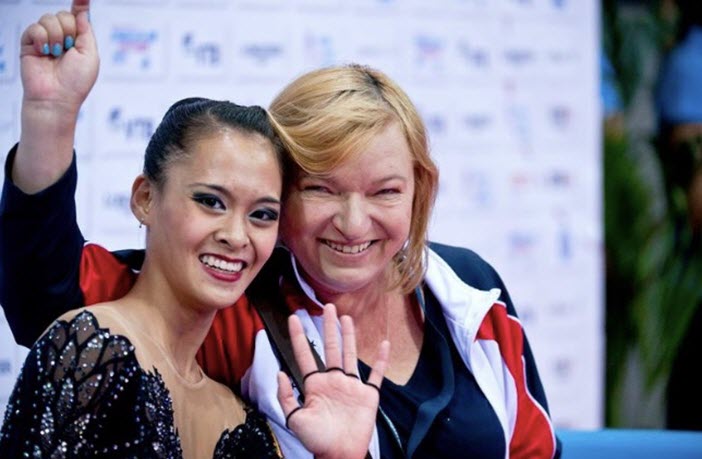
With Coach Nataliya Kiriyenko at 2015 World Championships (Stuttgart, Germany)
College
In 2016, Serena began school at Princeton University. When asked whether she ever considered taking a gap year for gymnastics, Serena replied, “I was hesitant about taking a gap year, partly because I personally didn’t want to put off school. I had goals to go to law school after college and wanted to make sure I was on track academically. In hindsight I didn’t realize how valuable a gap year could be, because I didn’t have that many resources to speak to about it. So I ruled out a gap year very quickly.”
The bigger question for Serena was, did she want to go to college and continue competitive gymnastics? “Pretty much no one before me had done it, especially at an Ivy League school. Given the colleges I got accepted to, I was pretty sure I was going to one of the Ivy’s. I know Ivy Leagues are hard, and I asked myself, ‘Am I going to be able to handle it?’ But at the time I was so incredibly passionate about gymnastics, and I had this huge dream to train for the 2020 Olympics. I had a very complicated relationship with gymnastics during my last couple years in the sport, and I needed to prove to myself that I could do it. I’m also a very stubborn person. If I decided to keep training, I’d want to go to a school close to my gym. I had a couple family friends who had gone to Princeton, and I spoke to them and visited the campus, and I absolutely loved it. It was a very easy decision. It was relatively close to my gym—a 45 minute to hour-and-a-half drive, and obviously is a stellar institution. Beyond academics, my decision was pretty unique from a lot of people who go Princeton. It was probably 75% fueled by my desire to stay in gymnastics.”
Serena’s transition to college life was a tumultuous one. “My transition was a lot harder than I had ever imagined it to be. Coming into Princeton freshman year, I was really excited, but I knew going in that my college experience would be drastically different than that of my peers. The biggest challenge automatically was academics and how I would be able to schedule that in with my evening practices. This is where I hit a lot of road bumps and crossroads that I don’t think even the school knew how to navigate. Princeton didn’t have many people in the past who were in the particular situation I was in. I tried to work with my advisors on how to schedule my classes in the morning. Freshman year gave me a lot of flexibility to do that because you’re still figuring out your major. I had to schedule all my classes in the morning, so that restricted the amount of classes I could take by three-fold. A lot of classes are in the afternoon, and I had to be gone from campus at 2:30pm. I had to take 8am classes, and I knew that would be very tough because I would be going to sleep very late [because of training].”
Regarding logistics, Serena says, “I took the train from campus to get to practice. My dad worked in New Jersey, so he would pick me up from the train station and drive me to the gym. Practice had to be a bit shorter especially with traffic. I had to change my training schedule to fit in everything I wanted to get done in a shorter amount of time. After practice, I would go back to school, and I’d get back around midnight. Fall semester was more manageable because it was off-season, so I could be on campus during the weekend evenings. In Spring semester, there were national team training camps and international competitions, so that made it much more challenging to balance.”
Serena describes one particular instance that illustrates the difficulty of her situation. “One time, I had to book a flight from France back to the US to take a mandatory class, then go to the airport that same evening and fly to Portugal [for a competition].”
How did she manage the gargantuan task of balancing life as a Princeton student and a USA national team member? “It was honestly exhausting, but I was able to do it that first year by being smart about scheduling and personal management. And of course, I would not have been able to do a quarter of the things I did without the unwavering support from my parents. Princeton didn’t make any excuses for me. It was hard to explain to Princeton the level I was competing at, because rhythmic gymnastics is not a recognized sport at any college yet. I talked to the school about using an open gym with one strip of carpet at 6:30am, so I could get additional training in. I felt bad about asking, even though I shouldn’t have, because at any university, if you are a university athlete, they usually supply resources and training equipment. For me, though, there were not many resources provided by the school, mainly because rhythmic isn’t a college sport. I remember using the basketball courts at 7am during open gym hours and doing parts of my routine on the floor with sneakers on because that was the only time I was able to use the gym.”
Balancing gymnastics at an Ivy League school was challenging on all fronts. “It was so strange because I went around campus and no one knew what I was doing. I essentially had to do it myself, because there was very little support or resources from the university. That is what discourages a lot of US rhythmic gymnasts from continuing the sport once they reach college. It’s really sad because a lot of these girls are hitting their peaks too early. A lot of people want to continue the sport into older ages. Many people in other countries are able to extend their careers to much older ages and get to enjoy the things that come with being in a sport for so long. You get a different sense of your body, different sense of your abilities, and you’re more mature about training and what you can and can’t do. It’s a shame that girls are discouraged to continue in college because they don’t have those resources to do so.”
Retirement and Transition Out of Gymnastics
Serena officially retired from gymnastics at the end of her sophomore year of college. The decision was one of the most difficult ones of her life. “I kept going back and forth about whether or not I should retire. Saying my decision was painful is an understatement. I had just finished the University Games in August, which was a one-of-a-kind experience and one of the most amazing points in my career. When I came back from the competition, however, I had this strange feeling of exhaustion. I had never felt that way before. Usually, after every competition, I would feel energized to tackle the next step of growth. This time, though, I was mentally and physically exhausted. I took some time for myself to rest and think about why I felt that way. I gave myself two to three weeks. After those weeks were up, I still couldn’t bring myself to go to the gym. I was frustrated with myself and tired of having to reorganize my schedule around school. I don’t think I was able to put myself in that box again. It was like pulling teeth, going back to balancing school and gymnastics.”
Despite all of her many achievements in life, Serena says, “I have really low confidence, and that was one of the biggest challenges of my career. I never thought I was good enough. My low self-confidence was pretty bad as a Junior competitor. It got a little better as a Senior, but I never reached the point where I could say, ‘I am proud of that routine.’ Success is hard for me to acknowledge. I was tired of feeling that I was under this microscope, where everything I did wasn’t good enough.”
Even for Serena, the stubbornly determined girl who never gave up, the pressure she faced as a college student and competitive gymnast was all-consuming and crippling. “I faced pressure from all angles. Some pressure was good, as it drove me to improve myself. But some pressure was bad that wore down my confidence and made me pessimistic about my abilities. Slowly, it broke down my personal determination. I am a stubborn gymnast and work really hard for the things I aim to achieve. That is why I ultimately feel like I failed. I wanted to prove to everyone in the country and, more importantly, prove to myself, that I was able to do both college and gymnastics and come out stronger, with my passion and determination carrying me through. But that passion kind of fizzled out because of everything that happened my freshman year. To this day, I still don’t feel like I achieved much in my career.”
Serena discusses extensively the emotional and psychological difficulties she faced when transitioning out of her sport. “I definitely didn’t know that the transition out would be as painful. It comes as a shock to so many of us. All endings are really tough. The reality is, most of us leave [the sport] without feeling prepared that it’s the end. It was hard to be 100% happy with what I’ve done and have a perfect ending to this chapter of my life. The harsh reality is not talked about enough. It took me so long to retire because I wanted [my retirement] to be on my own terms, and not because I felt like I had to. It was difficult feeling inadequate and not being able to reach my maximum. When you have a goal and pour your whole being into that, only to be disappointed in the end, it’s really hard. That difference between my dreams and my reality was devastating for me. To this day I am trying to reason with myself that just because I didn’t reach my goals doesn’t mean I didn’t succeed. I keep asking myself, ‘What if I had just continued?’ People tell you not to think of ‘what could have been’, but you just can’t help it. [Sports] is such a big part of your life; it’s your whole identity. And once you have that much disappointment, it wears down at your inner strength and all the other skills you’ve learned.”
Serena notes that the difficult transition happens to most competitive athletes at any level. “If you’re so passionate about something and you built your life and identity around your sport, leaving the sport is going to hurt to some degree. A lot of us have tried to keep that struggle internal and put up a front, pretending that we’re fine.”
The transition out of gymnastics made Serena’s sophomore year at Princeton one of the most difficult years of her life. “I spent a lot of sophomore year in a pretty low mood. My mental state was not as strong at the time. I like figuring out how to navigate hardships by myself first. It was definitely hard to talk about what I was going through with other people. I couldn’t talk to a lot of new people I met about gymnastics. My freshman year I had made maybe a couple of friends, just because I was never on campus. Once I stopped gymnastics, I started meeting new people and got into more on-campus activities. Everything was happening so fast, and despite all I was doing, I felt really empty. Everything about gymnastics was described in the past tense. ‘I used to be a gymnast.’ My parents have taught me how to be humble about the things I do, so I personally get uncomfortable trying to tell people about my gymnastics life. I don’t want people’s first impression of me to be like, ‘Oh, okay so you are a national team gymnast.’ In short, I tried to go through the process myself.”
It was difficult for Serena to confide in her gymnastics peers as well. “I shut out a lot of people in my gymnastics life. A lot of them were still competing, and I felt embarrassed that I had failed and wasn’t competing anymore. I wanted them to succeed without being a burden on them. I had some very very low points. It’s hard because life keeps going. I had to find a way to pick myself up without getting too caught up in the heartache. Getting over [gymnastics] at school made it more difficult. It was not the best place to be in during the transition out of gymnastics.”
To this day, Serena still grapples with the role gymnastics plays in shaping her identity. “Gymnastics still feels like huge part of my identity, and sometimes I don’t think I can ever be a person separate from the gymnast, since it comes with very unique experiences.”
Despite the immense difficulty of her transition out of the sport, Serena also recognizes the silver lining of it all. “While the transition was difficult, I came out a lot stronger and became a lot more multi-dimensional from it. I also enjoyed a new period of exploration and finding new interests beyond gymnastics. I am incredibly grateful for the place I am at today.”
Rebuilding an Identity
Indeed, the next step for Serena, upon leaving gymnastics, was finding a new passion. The process, while fulfilling, also held its own set of challenges. “The first question I was faced with was, ‘Should I try something totally new, or something I’m familiar with?’ The immediate connection to rhythmic gymnastics was dance. I had done ballet all throughout my gymnastics career. I decided to check out how the dance culture was at Princeton.”
Serena ended up joining two dance companies on campus. One was an East Asian dance company, and the other was a contemporary and hip-hop fusion company.
Another challenge Serena faced in the initial stages of her new life chapter was this idea of how she would be perceived by other people. “I was thrown into a new social group. I enjoyed it a lot, but in some ways, it made the transition harder. A part of me was trying to establish a new identity outside of gymnastics. I asked myself, ‘How do I want people to know me? How do I want to know myself?’ People very quickly found out I had done rhythmic gymnastics. They would say, ‘That’s the gymnast.’ I was trying to get past that and wanted to form a new identity.”
Yet another challenge Serena welcomed was the humbling experience of being a total beginner again, after spending her whole life in the pursuit of mastery of rhythmic gymnastics. “I have low self-confidence already, and I spent a lot of sophomore year trying to justify if dancing was something I wanted to do. You’re around people who’ve been dancing since they could walk. There are people who’ve been dancing their whole lives and have a vast vocabulary, whereas I was starting from scratch. I often thought to myself, ‘I could dance on campus, or I could go back to the gym where I know who I am.’ When you’re going through an identity turnover, it is hard to feel completely comfortable at first and it can sometimes feel like a toxic environment, but it is really inspiring at the same time. You sometimes have to be brave to take that step away from what is comfortable.”
While being a beginner was indeed difficult, there were parts of the process that Serena thoroughly enjoyed. “I hadn’t felt like being a beginner in a very long time. Starting from scratch was something I craved so much. I wanted to start from the beginning and go through the process of getting passionate about something and working on it and going through growing pains. There’s so much to learn, and seeing the end result of hard work is so fulfilling. I saw the opportunity for growth, which I’ve craved for so long, so I ultimately decided to stick with the dance community. I learned to be a lot more brave when it came to trying new things and not worrying about whether or not I was good at it, in the beginning. A lot of it comes from knowing that you have a lot of room for improvement. It’s important to not be too harsh on yourself. I tell myself, ‘I’m here to grow and I am here to learn.’”
One of the first things gymnasts face when they retire is weight gain, because they are no longer training rigorously. She says, “It was a physical manifestation of me losing that part of my life. Not only did I go through the mental struggle of losing my identity, I physically saw it too. It is unfortunate to be so conscious of it, and while I knew it was fine to gain weight, we [as athletes] have trained our whole lives to be aware of our bodies. [The weight gain] contributed to the reason why sophomore year was so hard. I look normal, and I am very healthy now. But in that moment, it was like, ‘Oh my goodness, I no longer have that muscle definition.’ A lot of being a rhythmic gymnast is your sense of feeling; you have such high awareness of your body, and losing that sense because I put on a little weight was really hard for me to deal with. It was a shock, even though everyone goes through it. It’s important to have a good perspective about it. It’s okay to gain weight, it’s totally fine as long as you are healthy, as you’re not training 30+ hrs a week anymore.”
Future Career Aspirations
Currently, Serena is a rising-senior at Princeton majoring in psychology whilst on the pre-law track. Her biggest goal right now is getting into law school. When asked what influenced her desire to become a lawyer, Serena says, “Since I was young, I have loved to debate. I love forming arguments. It happened a lot with my sister– whenever we argued, we both had fun trying to see who could prove their point better. From then on, I have been lucky to have a bit of exposure to different law-related fields and exposure has definitely continued to fuel my interest.”
In the summer of 2018, Serena got involved in the campaign team of Wendy Li, Civil Court Judge and former lawyer. “Wendy had been able to achieve so much and help so many people, and that really inspired me. I want to do something beyond myself and help my community. This experience, coupled with my general interest in law, drew me to becoming a lawyer. I can see how practicing law can affect people’s lives in a very personal way, and that is intriguing and rewarding to see.”
Advice to Young Gymnasts
Serena still keeps in touch with former teammates, many of whom are her closest friends. “At first I felt like I was missing out because they were still training and competing. I felt bad that I couldn’t share those experiences with them. Nowadays, I try to help them out and tell them about my experiences with hopes that it helps them in some way. It’s really nice to hear about their achievements and how training is going. Regardless of where we are, we are honestly a family. You just go through so much stuff together. We practically grew up together.”
Serena’s top three pieces of advice to current competitive rhythmic gymnasts are as follows:
1) “It’s okay to set high goals for yourself. I was scared to admit that the Olympics was my goal, because I was afraid of failing.”
2) “But it’s okay to also fail. I failed so many times, and you definitely come out of it a lot stronger. You go into it giving it your all. But know that if you fail, it’s not the end all be all. Every time I failed it really hit my self-confidence, which is really detrimental to your mental health as an athlete. Remember that there is always another opportunity to succeed, right around the corner.”
3) “Take it all in while you can. That’s something I wish I had done more of. I miss the simple enjoyment of being on the carpet and finishing my routine. I miss the feeling of training, and feeling like I physically did something amazing for myself. That’s a feeling I haven’t gotten back to this day. I miss going to national team camp, or having a hard practice but knowing I put in the work. Whenever I’d go to competition I would focus on how nervous I was, and that would take away from the enjoyment of being there. I was always very honored to represent the US in different places, but I’d get really stressed out preparing for it. Everyone works incredibly hard as an athlete, but just remember to take in all the little moments.”
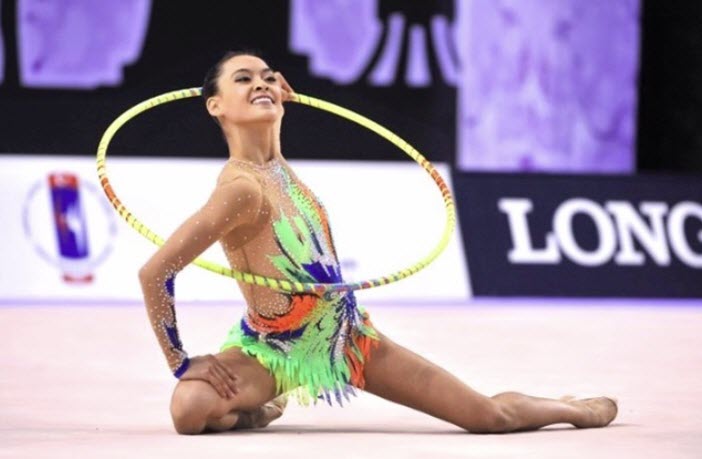
2014 World Championships (Izmir, Turkey)
When asked what her greatest takeaway from gymnastics was, Serena says, “I am so grateful for rhythmic, and the level of competition you get in this sport is unmatched. These girls are so strong, and I learned from a young age to remain calm under pressure. I learned what it really means to be on a team: nothing was more inspiring than seeing the process your teammates go through to achieve their goals. Rhythmic taught me to be able to handle negative criticism and not take criticism too personally, and ultimately grow from it. Rhythmic strengthened my character. A lot of us have gone through some very hard experiences. There were instances in my career where I felt some of the worst pain I have felt emotionally and physically—the kind of raw emotional pain that turns into physical pain. I draw on how strong I was then, and that helps me get through a lot of things now. I tell myself, ‘I’ve been through that, so I can get through anything.’”

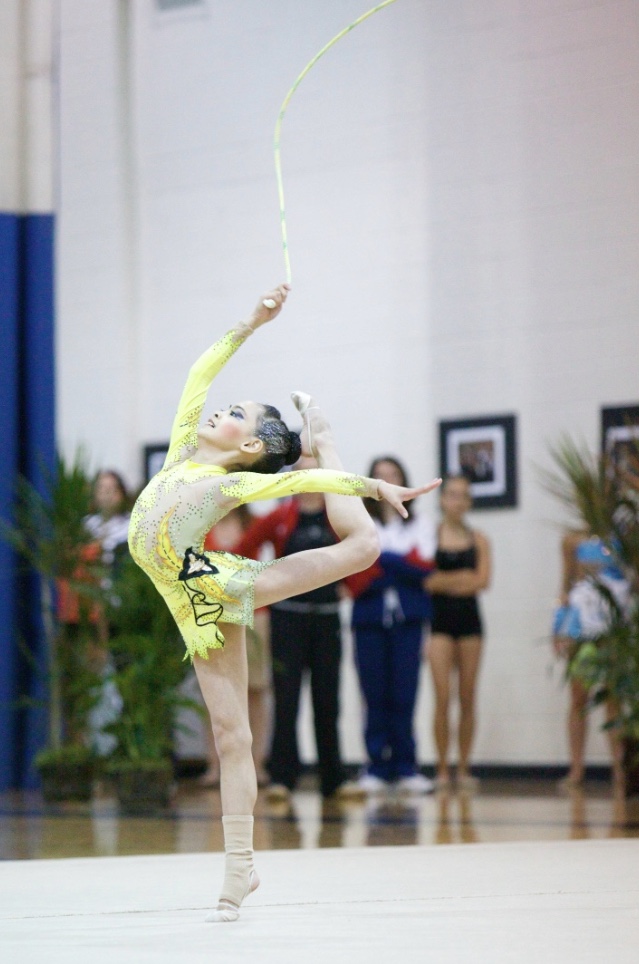
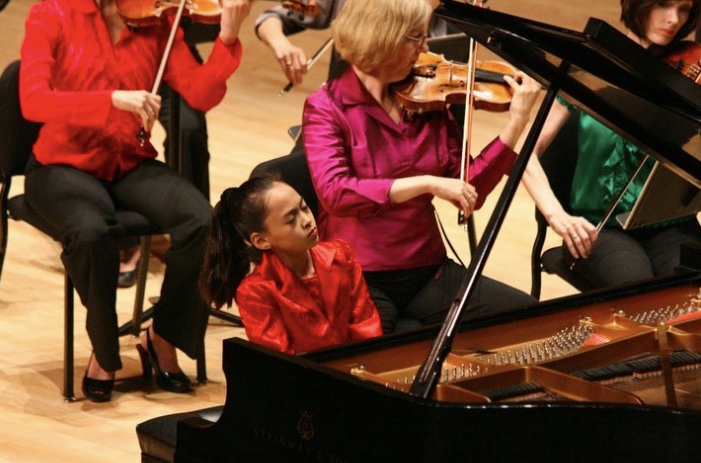


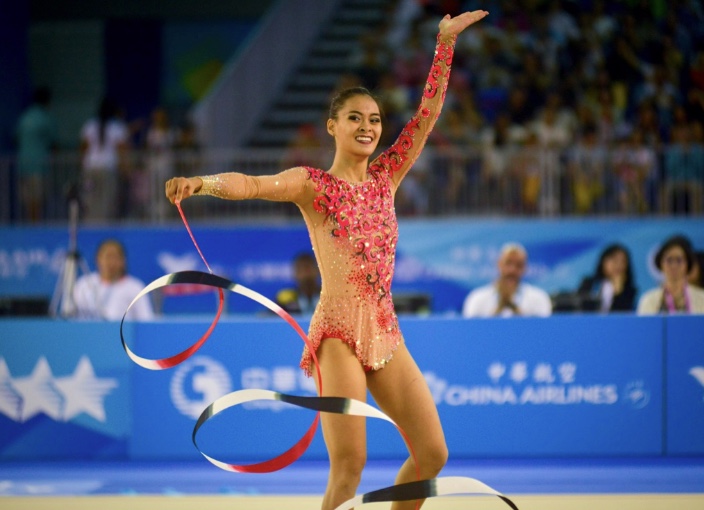
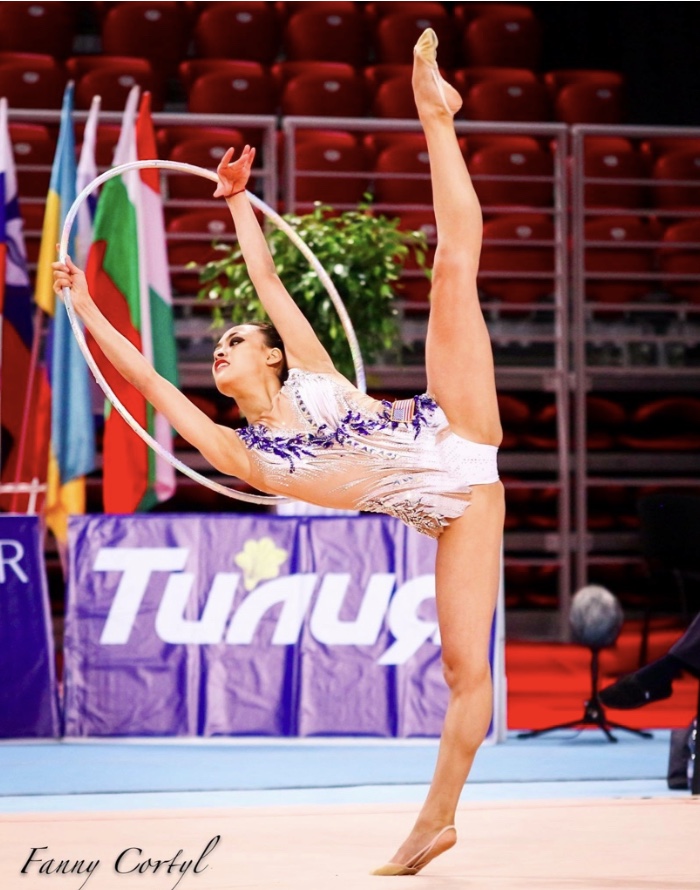
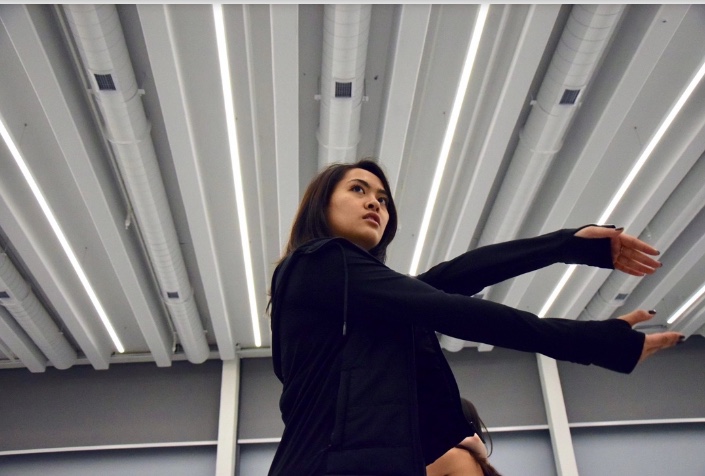
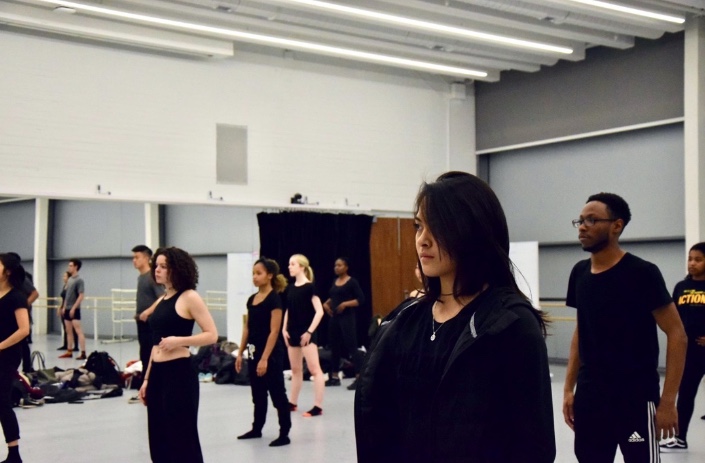
0 Comments